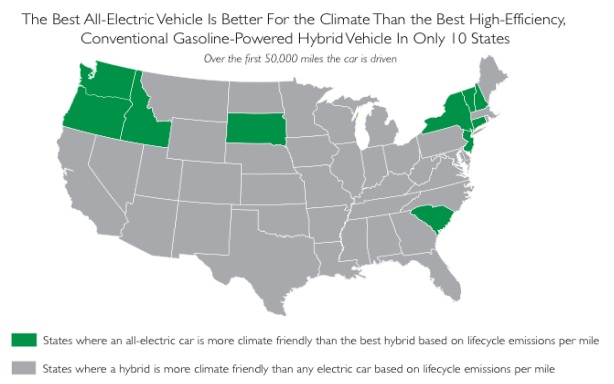A Roadmap to Climate-Friendly cars: 2013 (Climate Central)
By:
+David Herron; Date: 2021-01-03T23:53:24.277Z
Tags: Life Cycle »»»» Long Tail Pipe »»»» Climate Change
A report attempting to calculate full life-cycle environmental impact of manufacturing and driving electric cars, but ending up with a slanted picture saying Hybrids are cleaner than Electrics.
The report states a fairly obvious idea :- An electric car is only as green as the electricity used to power it.
The report doesn't seem to take into account the similar claim about gasoline powered cars. And it doesn't even bother to make the equivalent statement for gasoline power. Gasoline powered cars are only as green as the gasoline used to power it.
Does the GREET model take into account all the oil spills that occur?
The report notes the "rapid substitution of coal with natural gas and the adoption of substantial amounts of wind power" and the effect it has had to decarbonize electricity from 2010 to 2012. In big coal states, Pennsylvania, Virginia and Alabama, natural gas electricity has increased by about 10% while coal dropped the same. Similar trend in Texas. Wind is 8% of Texas' electricity, and is growing in other parts of the Midwest.
In other words - the electricity grid is getting greener all the time. Meaning that electric cars get greener all the time, while a gasoline car gets worse over its age because the engine starts clunking and sputtering and generally acting dirtier as it ages.

That's the key take-away idea.

This image shows a key reason why - the mix of electricity generation methods.

This is what we mentioned earlier - the grid is being decarbonized.
However, something they don't say, and most are not saying, is that this fact is coming about on the back of hydraulic fracturing and other extreme methods to extract natural gas. Without Fracking, we'd still be complaining about shrinking supplies of natural gas as was the discussion back in 2005.

And this is the effect on the "Driving Emissions" of the Nissan Leaf.
Note - they're carefully using the phrase "Driving Emissions".

The deal they're leading to is to claim that manufacturing an electric car requires more energy and resources than does a regular gas car or even does a Prius. More energy or resources means a bigger carbon debt. There is a growing body of evidence they cite to back them up on this claim, and it seems plausible enough.
In the 6th chapter, Methodology, they go over how these things are calculated. To get driving emissions for electric cars they went through educated guesstimates of the cleanliness of electricity in each state. Their methodology does not show a similar level of effort to measure the full emissions effect of gasoline - instead they give a table showing the pounds of CO2 from burning a given quantity of various fossil fuels - strongly implying that for the driving emissions of a gasoline car, they're stopping at the tailpipe, and not considering the emissions from further up the pipeline such as the refinery or everything else.
Original:
http://assets.climatecentral.org/pdfs/ClimateFriendlyCarsReport_Final.pdf
